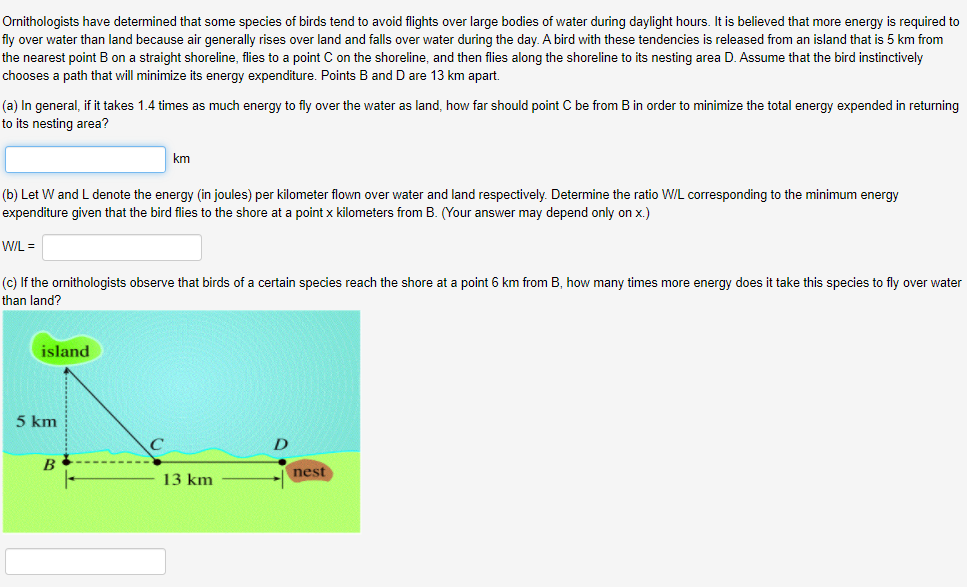Ornithologists have determined that some species of birds tend to avoid flights over large bodies of water during daylight hours. It is believed that more energy is required to fly over water than land because air generally rises over land and falls over water during the day. A bird with these tendencies is released from an island that is 5 km from the nearest point B on a straight shoreline, flies to a point C on the shoreline, and then flies along the shoreline to its nesting area D. Assume that the bird instinctively chooses a path that will minimize its energy expenditure. Points B and D are 13 km apart. (a) In general, if it takes 1.4 times as much energy to fly over the water as land, how far should point C be from B in order to minimize the total energy expended in returning to its nesting area? km (b) Let W and L denote the energy (in joules) per kilometer flown over water and land respectively. Determine the ratio W/L corresponding to the minimum energy expenditure given that the bird flies to the shore at a point x kilometers from B. (Your answer may depend only on x.) WIL = (c) If the ornithologists observe that birds of a certain species reach the shore at a point 6 km from B, how many times more energy does it take this species to fly over water than land?
Ornithologists have determined that some species of birds tend to avoid flights over large bodies of water during daylight hours. It is believed that more energy is required to fly over water than land because air generally rises over land and falls over water during the day. A bird with these tendencies is released from an island that is 5 km from the nearest point B on a straight shoreline, flies to a point C on the shoreline, and then flies along the shoreline to its nesting area D. Assume that the bird instinctively chooses a path that will minimize its energy expenditure. Points B and D are 13 km apart. (a) In general, if it takes 1.4 times as much energy to fly over the water as land, how far should point C be from B in order to minimize the total energy expended in returning to its nesting area? km (b) Let W and L denote the energy (in joules) per kilometer flown over water and land respectively. Determine the ratio W/L corresponding to the minimum energy expenditure given that the bird flies to the shore at a point x kilometers from B. (Your answer may depend only on x.) WIL = (c) If the ornithologists observe that birds of a certain species reach the shore at a point 6 km from B, how many times more energy does it take this species to fly over water than land?
Algebra & Trigonometry with Analytic Geometry
13th Edition
ISBN:9781133382119
Author:Swokowski
Publisher:Swokowski
Chapter2: Equations And Inequalities
Section2.7: More On Inequalities
Problem 44E
Related questions
Topic Video
Question
100%

Transcribed Image Text:Ornithologists have determined that some species of birds tend to avoid flights over large bodies of water during daylight hours. It is believed that more energy is required to
fly over water than land because air generally rises over land and falls over water during the day. A bird with these tendencies is released from an island that is 5 km from
the nearest point B on a straight shoreline, flies to a point C on the shoreline, and then flies along the shoreline to its nesting area D. Assume that the bird instinctively
chooses a path that will minimize its energy expenditure. Points B and D are 13 km apart.
(a) In general, if it takes 1.4 times as much energy to fly over the water as land, how far should point C be from B in order to minimize the total energy expended in returning
to its nesting area?
km
(b) Let W and L denote the energy (in joules) per kilometer flown over water and land respectively. Determine the ratio W/L corresponding to the minimum energy
expenditure given that the bird flies to the shore at a point x kilometers from B. (Your answer may depend only on x.)
WIL =
(c) If the ornithologists observe that birds of a certain species reach the shore at a point 6 km from B, how many times more energy does it take this species to fly over water
than land?
island
5 km
B
nest
13 km
Expert Solution
This question has been solved!
Explore an expertly crafted, step-by-step solution for a thorough understanding of key concepts.
This is a popular solution!
Trending now
This is a popular solution!
Step by step
Solved in 2 steps

Knowledge Booster
Learn more about
Need a deep-dive on the concept behind this application? Look no further. Learn more about this topic, advanced-math and related others by exploring similar questions and additional content below.Recommended textbooks for you

Algebra & Trigonometry with Analytic Geometry
Algebra
ISBN:
9781133382119
Author:
Swokowski
Publisher:
Cengage

Algebra: Structure And Method, Book 1
Algebra
ISBN:
9780395977224
Author:
Richard G. Brown, Mary P. Dolciani, Robert H. Sorgenfrey, William L. Cole
Publisher:
McDougal Littell

Linear Algebra: A Modern Introduction
Algebra
ISBN:
9781285463247
Author:
David Poole
Publisher:
Cengage Learning

Algebra & Trigonometry with Analytic Geometry
Algebra
ISBN:
9781133382119
Author:
Swokowski
Publisher:
Cengage

Algebra: Structure And Method, Book 1
Algebra
ISBN:
9780395977224
Author:
Richard G. Brown, Mary P. Dolciani, Robert H. Sorgenfrey, William L. Cole
Publisher:
McDougal Littell

Linear Algebra: A Modern Introduction
Algebra
ISBN:
9781285463247
Author:
David Poole
Publisher:
Cengage Learning

Elementary Geometry for College Students
Geometry
ISBN:
9781285195698
Author:
Daniel C. Alexander, Geralyn M. Koeberlein
Publisher:
Cengage Learning

Elementary Geometry For College Students, 7e
Geometry
ISBN:
9781337614085
Author:
Alexander, Daniel C.; Koeberlein, Geralyn M.
Publisher:
Cengage,

Trigonometry (MindTap Course List)
Trigonometry
ISBN:
9781337278461
Author:
Ron Larson
Publisher:
Cengage Learning